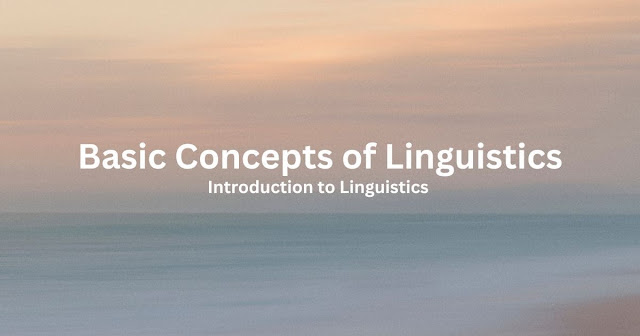Some Basic Concepts of Linguistics | Introduction to Linguistics

Language:
Definition: Language is a system of communication using symbols (like words, sounds, and gestures) to convey meaning.
Key Points: It's unique to humans, allows for complex expression, and varies across cultures.
Phonetics and Phonology:
Phonetics: Study of speech sounds and how they are produced, transmitted, and perceived.
Phonology: Study of the sound patterns of a particular language, including its phonemes (distinctive sound units) and phonological rules.
Morphology:
Definition: Study of the structure of words and how they are formed from smaller meaningful units called morphemes.
Key Points: Morphemes can be roots (core meaning) or affixes (prefixes, suffixes, infixes) that modify meaning or grammatical function.
Syntax:
Definition: Study of sentence structure and the rules governing word order, phrase structure, and sentence formation.
Key Points: Syntax determines how words are combined to create meaningful sentences and how those sentences are structured.
Semantics:
Definition: Study of meaning in language, including how words, phrases, and sentences convey meaning.
Key Points: Semantics explores literal meaning, connotations, ambiguity, and how meaning can vary across contexts.
Pragmatics:
Definition: Study of language use in context and the ways in which context influences meaning.
Key Points: Pragmatics deals with aspects such as speech acts (e.g., requesting, promising), conversational implicature, and politeness strategies.
Sociolinguistics:
Definition: Study of how language varies and changes within social groups and across different contexts.
Key Points: Sociolinguistics examines factors like social identity, power dynamics, language attitudes, and language variation (e.g., dialects, registers).
Psycholinguistics:
Definition: Study of the psychological processes involved in language comprehension, production, acquisition, and representation.
Key Points: Psycholinguistics investigates topics like language processing, memory, language development, and language disorders.
Historical Linguistics:
Definition: Study of how languages change over time and the relationships between languages.
Key Points: Historical linguistics explores language evolution, language families, language contact, and the reconstruction of past languages.
Applied Linguistics:
Definition: Application of linguistic theories and methods to practical issues in areas such as language teaching, translation, language planning, and language policy.
Key Points: Applied linguistics addresses real-world language-related problems and seeks to improve language learning and communication in diverse contexts.
 Reviewed by Tawhidul Islam
on
May 14, 2024
Rating:
Reviewed by Tawhidul Islam
on
May 14, 2024
Rating:





.png)
No comments